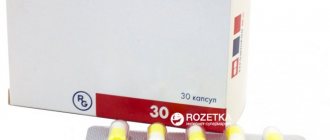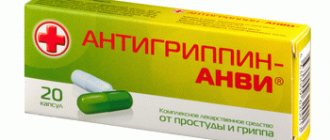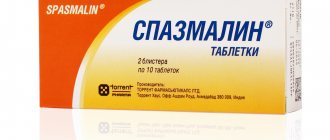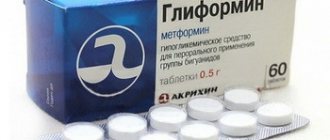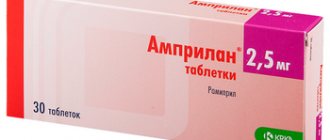Pharmacological action of Cimetidine
Cimetidine is a histamine H2 receptor blocker. Suppresses the production of hydrochloric acid stimulated by food, gastrin, histamine and acetylcholine. By decreasing the level of hydrochloric acid, it increases the pH level and decreases the activity of pepsin.
Cimetidine triggers the protective mechanism of the gastric mucosa, healing damage caused by the action of hydrochloric acid. Reduces the concentration of cytochrome P450. Does not affect adrenergic receptors, does not have an anesthetic effect. After taking Cimetidine orally, the therapeutic effect occurs within 1 hour and continues to act for 4-5 hours.
Pharmacokinetics
Cimetidine is completely absorbed from the gastrointestinal tract. Metabolism occurs on the first pass. Bioavailability of the drug is 60-70%. The maximum concentration in blood plasma, when taken on an empty stomach, is reached after 1 hour, after 3 hours a second peak may be observed. Cimetidine is distributed in the tissues of the body. The level of binding to plasma proteins is 20%.
The half-life of Cimetidine is approximately 2 hours; it may increase with renal dysfunction. It is excreted mainly unchanged in the urine. The clearance of cimetidine increases in patients with burns.
Indications for use
- peptic ulcer of the stomach and duodenum in the acute phase;
- exacerbation of peptic ulcer (for prevention);
- symptomatic ulcers;
- erosive and reflux esophagitis;
- Zollinger-Ellison syndrome;
- heartburn associated with hyperchlorhydria;
- prevention of recurrent bleeding from the upper gastrointestinal tract (GIT) and in the postoperative period;
- erosive and ulcerative lesions of the upper gastrointestinal tract (for prevention);
- systemic mastocytosis;
- polyendocrine adenomatosis;
- rheumatoid arthritis, acute urticaria, pancreatic enzyme deficiency (as an auxiliary treatment).
Cimetidine dosage
Cimetidine instructions recommend setting the dosage based on the general condition of the patient. For adult patients, a single dose is 100-800 mg.
With intravenous administration of Cimetidine, a single dose is 200 mg, with intravenous infusion - 400 mg. The maximum permissible daily dose, regardless of the method of administration, should not exceed 2 g.
The maximum permissible dose of Cimetidine for children aged 1 year and older, regardless of the route of administration, is 25-30 mg/kg/day in separate doses. Children under one year of age – 20 mg/kg/day.
Release form and composition
Dosage forms of Cimetidine:
- tablets (in packs of 30 pieces, 0.8 g; 60 pieces, 0.4 g; 120 pieces, 0.2 g);
- film-coated tablets (in blister packs of 10 pcs., in a cardboard pack of 10 packs);
- capsules;
- retard tablets;
- syrup (in bottles);
- solution for injection (in ampoules).
The active substance is cimetidine in the dosage forms of the drug:
- tablets: 1 pc. – 0.2; 0.4 or 0.8 g;
- film-coated tablets: 1 pc. – 0.2 g;
- retard tablets: 1 pc. – 0.35 g;
- capsules: 1 pc. – 0.2 g;
- syrup: 1 teaspoon – 0.2 g;
- injection solution: 0.2 g.
Interaction of Cimetidine with other drugs
Concomitant use with antacids containing aluminum hydroxide and magnesium hydroxide may result in decreased absorption of cimetidine. When combined with sulfonylurea derivatives - hypoglycemic agents - hypoglycemia is sometimes observed.
Combinations of Cimetidine with chlordiazepoxide, clorazepate, triazolam, alprazolam, diazepam, clobazam, nitrazepam, flurazepam lead to an increase in the concentration of benzodiazepines in the blood plasma. May enhance sedative effects.
Concomitant use increases the concentration of amiodarone in the blood due to a slowdown in its metabolism.
The combination of cimetidine with atenolol in some cases causes severe bradycardia.
When taken simultaneously with benzylpenicillin, it increases its bioavailability.
Simultaneous use with vecuronium chloride, verapamil, gallopamil enhances the effect of these drugs.
Combination with indomethacin leads to a decrease in its concentration in the blood plasma, without affecting its anti-inflammatory effect.
Combination with ketoconazole and itraconazole reduces their absorption in the gastrointestinal tract.
Cimetidine reduces the clearance of lidocaine and increases its concentration in the blood plasma, which may lead to increased side effects of lidocaine.
Instructions:
Clinical and pharmacological group
11.001 (Histamine H2 receptor blocker. Antiulcer drug)
pharmachologic effect
First generation histamine H2 receptor blocker. Suppresses the production of hydrochloric acid, both basal and stimulated by food, histamine, gastrin and, to a lesser extent, acetylcholine. Simultaneously with a decrease in hydrochloric acid production and an increase in pH, pepsin activity decreases.
Induces protective mechanisms of the gastric mucosa and promotes the healing of its damage associated with the effects of hydrochloric acid (including the cessation of gastrointestinal bleeding and scarring of stress ulcers), by increasing the formation of gastric mucus, increasing the concentration of glycoproteins in it, stimulating the secretion of mucosal bicarbonate the lining of the stomach, endogenous synthesis of prostaglandins in it and the rate of regeneration. Reduces the concentration of reduced cytochrome P450 and significantly inhibits the aniline hydroxylase activity of microsomal liver enzymes. Does not affect adrenergic receptors, does not have a local anesthetic effect.
In urticaria, it blocks histamine H2 receptors in the blood vessels of the skin, which are partly responsible for the development of the inflammatory reaction. Has an antiandrogenic effect (blocks dihydrotestosterone). Causes a transient (no clinical significance) increase in prolactin concentration (only with intravenous jet administration).
After oral administration at a dose of 300 mg, the therapeutic effect begins within 1 hour and lasts for 4-5 hours.
Pharmacokinetics
After oral administration, cimetidine is completely absorbed from the gastrointestinal tract. Cmax in blood plasma is achieved 1 hour after ingestion on an empty stomach, the second peak can be observed after 3 hours. When eating food, the time to reach Cmax increases to 2 hours. Metabolized during the “first pass” through the liver. The bioavailability of cimetidine after oral administration is 60-70%. Partially metabolized in the liver to form sulfoxide and hydroxymethylcymetidine.
Cimetidine is widely distributed in body tissues, Vd is about 1 l/kg. Plasma protein binding is about 20%.
T1/2 is about 2 hours and increases with impaired renal function. It is excreted mainly in the urine unchanged.
Cimetidine is removed from the body by hemodialysis, but is slightly removed by peritoneal dialysis.
In patients with burns, the clearance of cimetidine is increased.
Cimetidine may inhibit the hepatic metabolism of other drugs by binding to cytochrome P450 isoenzymes, especially CYP1A2, CYP2C9, CYP2D6 and CYP3A4.
Dosage
The treatment regimen is determined individually.
For adults, when taken orally, a single dose is 100-800 mg.
For intravenous injection, a single dose is 200 mg, for intravenous infusion, 400 mg; for continuous intravenous infusion, a dose of 50-100 mg/hour is recommended.
For intramuscular administration, a single dose is 200 mg.
The maximum daily dose for adults is 2.4 g, regardless of route of administration.
The maximum dose for children over 1 year of age when taken orally or parenterally is 25-30 mg/kg/day in divided doses; for children under 1 year of age - 20 mg/kg/day.
Drug interactions
When used simultaneously with antacids containing magnesium hydroxide and aluminum hydroxide, the absorption of cimetidine may be reduced.
When used simultaneously with oral hypoglycemic agents, sulfonylurea derivatives, hypoglycemia was observed in rare cases.
When used simultaneously with tricyclic antidepressants, the concentration of tricyclic antidepressants in the blood plasma increases due to inhibition of their metabolism in the liver under the influence of cimetidine.
When used simultaneously with alprazolam, chlordiazepoxide, clobazam, clorazepate, diazepam, flurazepam, nitrazepam, triazolam, the concentration of benzodiazepines in the blood plasma increases due to inhibition of their metabolism in the liver under the influence of cimetidine. Possible increased sedative effect.
With simultaneous use, the concentration of alfentanil in the blood plasma increases.
With simultaneous use, the concentration of amiodarone in the blood plasma increases due to a slowdown in its metabolism under the influence of cimetidine.
When used simultaneously with atenolol, a case of the development of severe bradycardia has been described.
It is possible to increase the bioavailability of benzylpenicillin with simultaneous oral administration.
When used simultaneously with bopindolol, the concentration of bopindolol in the blood plasma increases; with bupivacaine - it is possible to increase the concentration of bupivacaine in the blood plasma; with valproic acid - the clearance of sodium valproate is slightly reduced, which may have clinical significance; with warfarin - the anticoagulant effect of warfarin may be enhanced and the risk of bleeding may increase.
When used simultaneously with vecuronium chloride, the effects of vecuronium chloride are enhanced; with verapamil - the effects of verapamil are enhanced; with gallopamil - the bioavailability of gallopamil increases by 40-50%; with dapsone - the concentration of dapsone in the blood plasma increases.
When used simultaneously with digoxin, both an increase and a decrease in the concentration of digoxin in the blood plasma is possible.
When used concomitantly with disopyramide, there is a report of a slight increase in the concentration of disopyramide in the blood plasma.
When used simultaneously with diltiazem and nifedipine, the concentration of diltiazem and nifedipine in the blood plasma increases due to inhibition of their metabolism in the liver under the influence of cimetidine. The effects of diltiazem and nifedipine may be enhanced.
When used simultaneously with zalcitabine, the concentration of zalcitabine in the blood plasma increases; with zidovudine - the renal secretion of zidovudine decreases, while its concentration in the blood plasma remains virtually unchanged.
When used simultaneously with indomethacin, a slight decrease in the concentration of indomethacin in the blood plasma is observed, with virtually no change in its anti-inflammatory effect.
In patients receiving carbamazepine, a transient increase in its plasma concentration is possible for several days after starting cimetidine, which may be accompanied by increased side effects.
When used simultaneously with carvedilol, the AUC of carvedilol increases without changing its Cmax in blood plasma.
When used simultaneously with carmustine, myelodepression increases and there is a risk of developing severe neutropenia and thrombocytopenia.
With simultaneous use, the absorption of ketoconazole and itraconazole from the gastrointestinal tract decreases.
A case has been described of an increase in the concentration of clozapine in the blood plasma and the development of toxic effects with the simultaneous use of cimetidine with clozapine.
When used simultaneously with lacidipine, nimodipine, nisoldipine, nitrendipine, felodipine, the concentration of calcium channel blockers in the blood plasma increases.
With simultaneous use, there may be a slight decrease in the absorption of levothyroxine from the gastrointestinal tract.
With simultaneous use, the clearance of lidocaine moderately decreases and its concentration in the blood plasma increases, there is a risk of increased side effects of lidocaine.
When used simultaneously with loratadine, the concentration of loratadine in the blood plasma increases, no increased side effects were noted; with lornoxicam - the concentration of lornoxicam in the blood plasma increases; with mebendazole - the concentration of mebendazole in the blood plasma increases and its effectiveness increases.
When used concomitantly, cimetidine may reduce the gastrointestinal side effects of mexiletine.
When used simultaneously with melphalan, its bioavailability increases; with methadone - cases of apnea development in elderly patients have been described; with metformin - there may be a decrease in the clearance of metformin, the risk of developing lactic acidosis.
When used simultaneously with moclobemide, the concentration of moclobemide in the blood plasma increases and side effects increase; with moracizine - the concentration of moracizine in the blood plasma increases; with morphine - the inhibitory effect of morphine on breathing may be enhanced; with nebivolol - an increase in the concentration of nebivolol in the blood plasma is possible.
When used simultaneously with paroxetine, it is possible to increase the concentration of paroxetine in the blood plasma due to inhibition of its metabolism and reduced excretion, and there is a risk of increased side effects; with pindolol - it is possible to increase the concentration of pindolol in the blood plasma; with pirenzepine - there are reports of increased clinical effectiveness of cimetidine; with praziquantel - the concentration of praziquantel in the blood plasma increases significantly; with procainamide - the concentration of procainamide in the blood plasma increases and there is a risk of increased side effects, especially in elderly patients and with impaired renal function. This is due to a decrease in the excretion of procainamide by the kidneys under the influence of cimetidine by almost 1/3 or more.
When used simultaneously with propafenone, a slight increase in the concentration of propafenone in the blood plasma and an increase in the duration of the QRS are possible.
Cimetidine inhibits the activity of microsomal liver enzymes (including the CYP2D6 isoenzyme), this leads to inhibition of the metabolism of propranolol and metoprolol. Arterial hypotension may develop, as well as increased side effects of beta-blockers, especially in patients with impaired liver function.
When used simultaneously with riodipine, the concentration of riodipine in the blood plasma increases due to a slowdown in its metabolism in the liver under the influence of cimetidine.
When used simultaneously with rifampicin, the extrarenal clearance of cimetidine increases by 50%, which is apparently due to the induction of microsomal liver enzymes under the influence of rifampicin. Because total clearance is not affected, this interaction is believed to be of little clinical significance.
When used simultaneously with sertraline, the concentration of sertraline in the blood plasma moderately increases; with sucralfate - a slight decrease in the bioavailability of cimetidine cannot be ruled out; with theophylline - the concentration of theophylline in the blood plasma increases due to inhibition of its metabolism in the liver (mainly N-demethylation) under the influence of cimetidine, the toxic effect of theophylline develops.
With simultaneous use with terfenadine, a case of the development of ventricular arrhythmias has been described, apparently due to inhibition of the metabolism of terfenadine under the influence of cimetidine, which is a nonspecific inhibitor of microsomal liver enzymes.
When used simultaneously with phenindione, the anticoagulant effect of phenindione is enhanced due to a slowdown in its metabolism in the liver under the influence of cimetidine, which is an inhibitor of microsomal liver enzymes.
When used simultaneously with phenytoin, the concentration of phenytoin in the blood plasma increases and a toxic effect develops, very rarely - myelodepression.
When used simultaneously with fentanyl, the effects of fentanyl may be enhanced; with flecainide - the concentration of flecainide in the blood plasma increases due to a decrease in its renal clearance and metabolism in the liver under the influence of cimetidine; with fluvastatin - increased absorption of fluvastatin is possible; with fluorouracil - the concentration of fluorouracil in the blood plasma increases by 75%, the side effects of fluorouracil increase.
When used simultaneously with quinidine, the concentration of quinidine in the blood plasma increases, and there is a risk of increased side effects; with quinine - it is possible to reduce the excretion of quinine and increase its T1/2, there is a risk of increased side effects; with chloramphenicol - cases of severe aplastic anemia have been described; with chlorpromazine - there are reports of both a decrease and an increase in the concentration of chlorpromazine in the blood plasma.
When used simultaneously with cyclosporine, a slight increase in the concentration of cyclosporine in the blood plasma cannot be excluded; with citalopram - it is possible to increase the concentration of citalopram in the blood plasma; with enalapril - an increase in T1/2 of enalapril and an increase in its concentration in the blood plasma.
With simultaneous use, the plasma concentration of enoxacin (with intravenous administration), fleroxacin (with intravenous administration), and pefloxacin (with oral administration) increases; with epirubicin - the concentration of epirubicin in the blood plasma increases; with erythromycin - cimetidine inhibits the process of N-demethylation of erythromycin, so its metabolism and clearance from the body slows down, which leads to an increase in its concentration in the blood plasma and the possible development of side effects (nausea, vomiting, diarrhea, abdominal discomfort).
Use during pregnancy and lactation
Use with caution during pregnancy and lactation.
It should be borne in mind that cimetidine penetrates the placental barrier and is excreted in breast milk.
Side effects
From the digestive system: nausea, vomiting, diarrhea, pancreatitis, hepatitis, jaundice, flatulence, increased activity of liver transaminases, decreased absorption of vitamin B12; with abrupt withdrawal - relapse of peptic ulcer.
From the central nervous system and peripheral nervous system: increased fatigue, drowsiness, dizziness, depression, hallucinations, emotional lability, anxiety, agitation, headache, nervousness, psychosis, confusion (more often in elderly patients with impaired liver and/or kidney function), decreased libido, hyperthermia.
Allergic reactions: skin rash, itching, hyperemia, angioedema, erythema multiforme, exfoliative dermatitis, Stevens-Johnson syndrome, toxic epidermal necrolysis.
From the endocrine system: possible (especially when used in high doses in men) gynecomastia, decreased potency.
From the hematopoietic system: rarely - leukopenia, neutropenia, thrombocytopenia, agranulocytosis, pancytopenia, eosinophilia, aplastic and hemolytic anemia.
From the cardiovascular system: bradycardia, tachycardia, AV block, with rapid intravenous administration - arrhythmias (in exceptional cases - asystole), decreased blood pressure, vasculitis.
From the urinary system: interstitial nephritis (hypercreatininemia, increased urea concentration), urinary retention.
From the musculoskeletal system: polymyositis, myalgia, arthralgia.
Other: hair loss.
Indications
Peptic ulcer of the stomach and duodenum in the acute phase, prevention of exacerbations of peptic ulcer disease, symptomatic ulcers, erosive and reflux esophagitis, Zollinger-Ellison syndrome, heartburn (associated with hyperchlorhydria), prevention of erosive and ulcerative lesions of the upper gastrointestinal tract, prevention of recurrent bleeding from the upper sections of the gastrointestinal tract and in the postoperative period, systemic mastocytosis, polyendocrine adenomatosis.
As an auxiliary therapy - deficiency of pancreatic enzymes, urticaria (acute form), rheumatoid arthritis.
Contraindications
Hypersensitivity to cimetidine.
special instructions
Use with caution in patients with chronic heart failure, diseases of the hematopoietic organs, liver and/or kidney failure, liver cirrhosis with a history of portosystemic encephalopathy, immunosuppression, in children and adolescents under 16 years of age.
Before starting treatment, it is necessary to exclude the possibility of a malignant disease of the esophagus, stomach or duodenum.
In patients with impaired liver and/or kidney function, dosage adjustment is required.
In elderly patients, with severe illnesses, and with impaired renal function, a reversible impairment of consciousness is possible.
It is not advisable to discontinue cimetidine abruptly due to the risk of relapse of peptic ulcer disease. With long-term use, systematic monitoring of the functional state of the liver and the picture of peripheral blood is necessary.
The simultaneous use of cimetidine and drugs that inhibit hematopoiesis is not recommended.
Side effects of Cimetidine
- with abrupt withdrawal of Cimetidine, relapses of peptic ulcer are possible;
- vomiting, pancreatitis, flatulence, hepatitis, nausea, diarrhea, jaundice;
- drowsiness, depression, increased fatigue, dizziness, emotional lability, hallucinations, agitation, anxiety, nervousness, psychosis, headache, hyperthermia, confusion, decreased libido;
- itching, skin rash, hyperemia, exfoliative dermatitis, erythema multiforme, angioedema, Stevens-Johnson syndrome;
- possible in men (especially at high doses): decreased potency, gynecomastia;
- rarely - thrombocytopenia, leukopenia, pancytopenia, neutropenia, agranulocytosis, aplastic and hemolytic anemia, eosinophilia;
- bradycardia, AV block, tachycardia, decreased blood pressure, vasculitis;
- interstitial nephritis, urinary retention;
- arthralgia, myalgia, polymyositis;
- hair loss.
special instructions
Cimetidine should be used with caution in patients with chronic heart failure, diseases of the hematopoietic organs, liver cirrhosis, renal or hepatic failure, immunosuppression, children and adolescents under 16 years of age.
Before starting the course, you should make sure that the patient does not have malignant diseases of the digestive system.
Patients with renal or liver dysfunction require a specially adjusted dosage regimen.
With long-term use, it is necessary to systematically monitor the condition of the liver and blood. Cimetidine instructions do not recommend abruptly stopping the drug due to the risk of relapse of peptic ulcer.
Doctor's review
Alexander Pichugin Doctor of the highest category,
“Cimetidine allows you to use it regularly and occasionally, eliminating not only the consequences of allergies, but also its causes. Using the drug for the first time, you can get rid of tearfulness, swelling, runny nose, nasal congestion, itching and rashes, cough and shortness of breath. To protect yourself from allergic manifestations during the allergy season, you need to use this drug as a course. As an additional effect, the drug restores metabolic reactions, cleanses the body of toxins and waste, increases immune resistance, improves overall well-being, and increases performance. This product participated in clinical trials and received certificates of conformity.”
